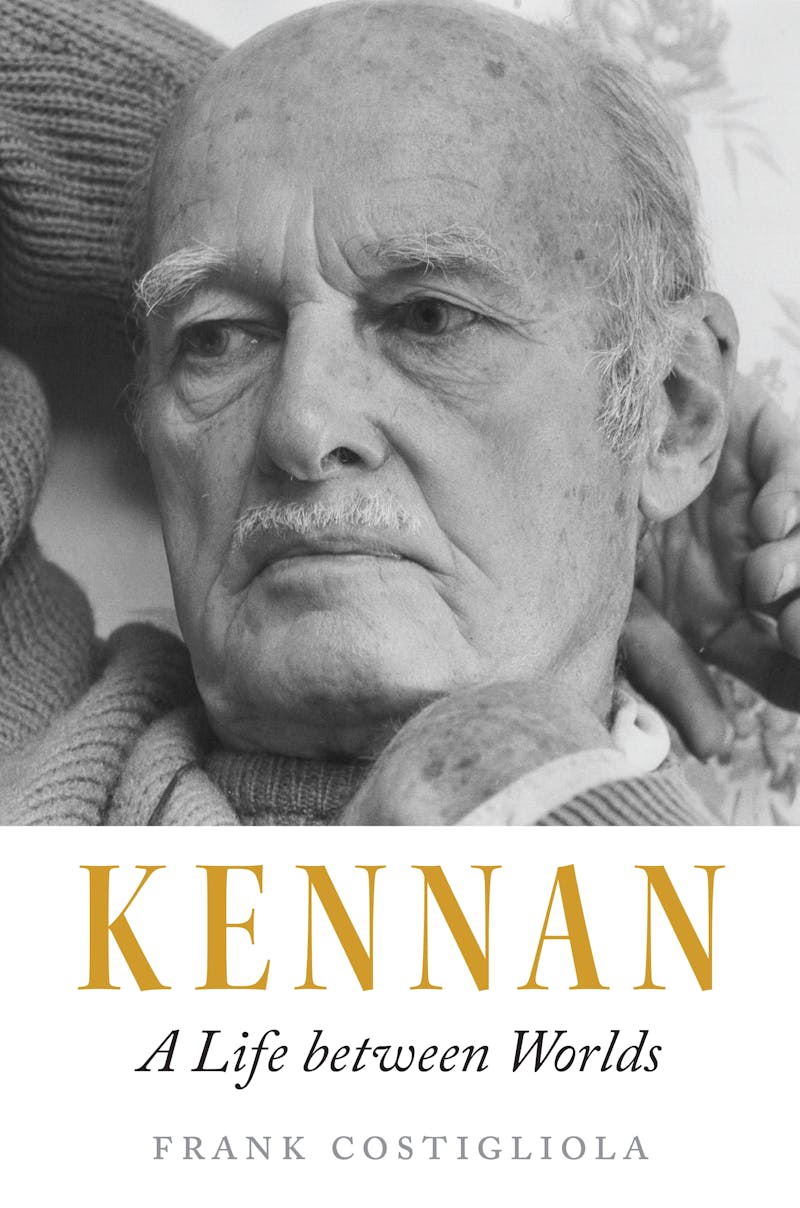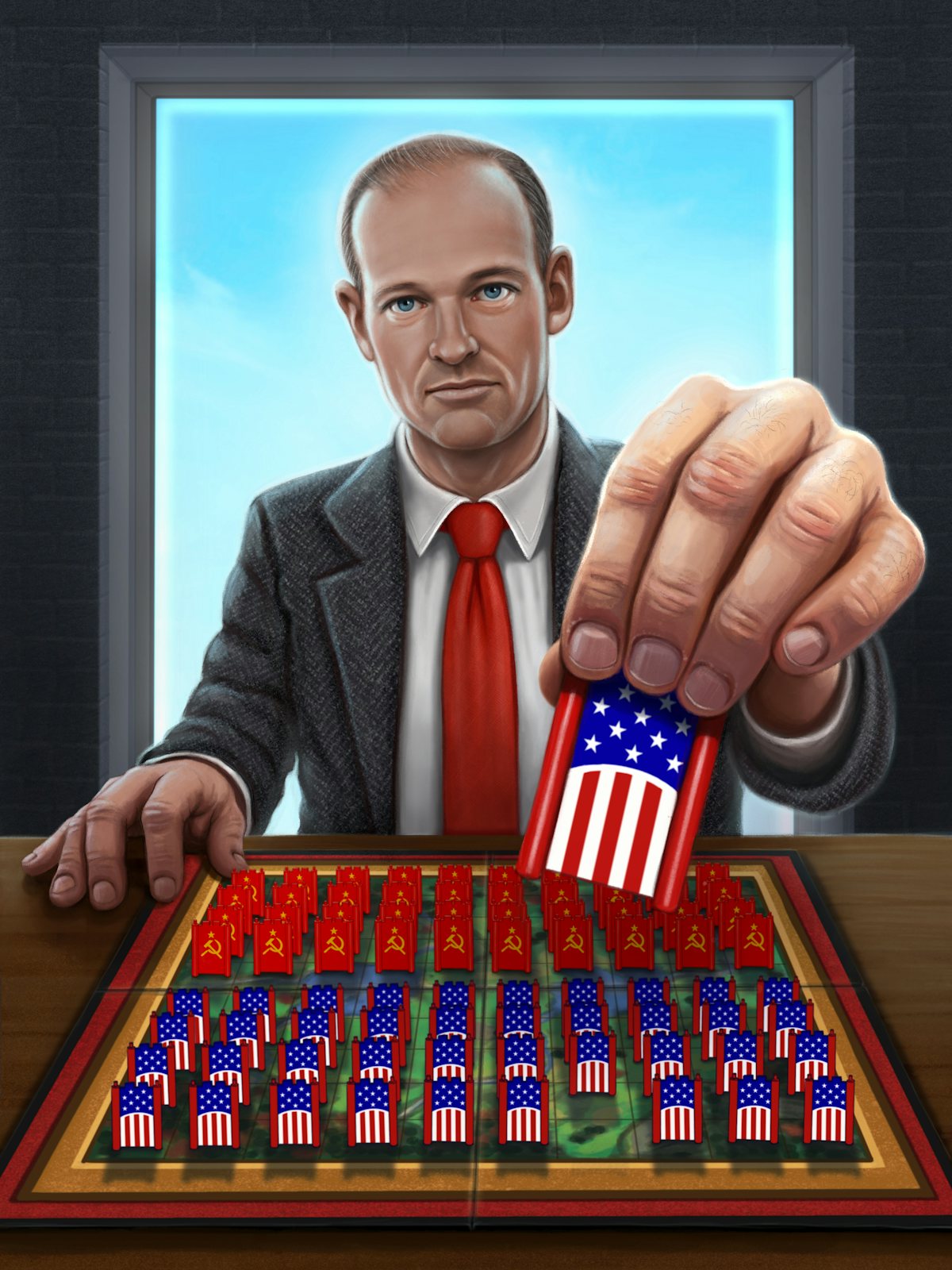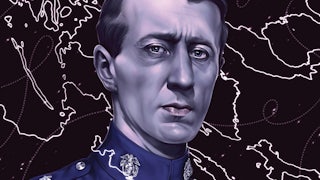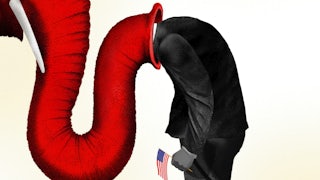George Kennan is considered a singular figure in U.S. diplomatic history. In a life that spanned 101 years—from the presidency of Theodore Roosevelt to that of George W. Bush—he won the Pulitzer and the National Book Award twice, the Bancroft Prize, the Presidential Medal of Freedom, and the Albert Einstein Peace Prize. Henry Kissinger, perhaps his only rival for influence as a scholar-diplomat, described him as having come “as close to authoring the diplomatic doctrine of his era as any diplomat in our history.” His authorized biographer, John Lewis Gaddis, called him “the most graceful prose stylist to serve in Washington in modern times.” But George Kennan was frequently full of regrets. He felt, over much of his lifetime, that his advice was ignored, his contributions misunderstood, and that he himself was personally inadequate.
For such a prolific writer, Kennan’s legacy is bound up with two short pieces. One is, ironically, known as the “Long Telegram”—at around 5,400 words, it broke traditional limits for State Department communication. In 1946, the Truman administration was trying to work out its policy toward the Soviet Union, which had only recently been an ally in the war against the Axis powers but now appeared hostile and suspicious. Kennan, who had served multiple postings in the U.S. Embassy in Moscow, provided an explanation. He described the USSR as a “force committed fanatically to the belief that with US there can be no permanent modus vivendi, that it is desirable and necessary that the internal harmony of our society be disrupted, our traditional way of life be destroyed, the international authority of our state be broken, if Soviet power is to be secure.” It circulated quickly and widely.

The next year, Kennan made a second legendary contribution via an article published in Foreign Affairs, which initially appeared under the pseudonym “X.” That article, “THE SOURCES OF SOVIET CONDUCT,” similarly warned that the Soviet Union was driven by ideology. Nonetheless, he insisted, it remained far weaker than the Western world, and “may well contain deficiencies which will eventually weaken its own total potential.” Kennan advised a “policy of firm containment, designed to confront the Russians with unalterable counter-force at every point where they show signs of encroaching upon the interests of a peaceful and stable world.” Though his writings were not the only sources for these ideas, they were forceful and powerful justifications for policies on which the United States was embarking.
But the “architect of containment” soon began to be dissatisfied with the way the contractors were erecting the building he had designed. Already by 1948 he was complaining that he had not intended containment to be a militarized program of confrontation. In the more than 50 years that he lived after that, he was a frequent critic of U.S. foreign policy. Considered one of the founders of realism—the doctrine that the United States should pursue its interests, not have a foreign policy driven by moral considerations—he frequently criticized U.S. military interventions abroad, from Vietnam to Iraq. He believed strongly—and said quite clearly in both the Long Telegram and “THE SOURCES OF SOVIET CONDUCT”—that the United States had to do work at home in order to “measure up to its own best traditions and prove itself worthy of preservation as a great nation.”
With such a career, Kennan has long been an object of fascination. The first volume of his own memoirs, which won both the Pulitzer and the National Book Award, appeared in 1967. Intellectual biographies by others have been appearing regularly for more than three decades, and could now fill a shelf. His legacy is as contested as the origins of the Cold War itself. John Lewis Gaddis’s widely adopted analysis, Strategies of Containment, was published in 1982. It praises Kennan as a wise grand strategist who designed an appropriate response for the United States to the Soviet challenge. Others have taken issue with his assumptions, or discovered unsavory drafts among his unpublished papers. But one might have thought that the metaphorical door had been shut on Kennan biographies when Gaddis published an authorized biography in 2011. At nearly 800 pages, the book drew fully from Kennan’s papers and the more than 30-year friendship between author and subject; it won the Pulitzer Prize for biography in 2012.
But Frank Costigliola—who, like Gaddis, is a distinguished diplomatic historian—was not convinced. Gaddis’s traditional interpretation of the Cold War, in which a morally and institutionally superior United States prevailed, in the long run, against a totalitarian enemy, caused him to be dismissive of Kennan’s criticisms of U.S. policy. Kennan had once selected Gaddis to be his authorized biographer because they agreed on the shallowness of some New Left historians’ criticisms of Kennan’s early work. But as Kennan survived much longer than he expected, he himself seemed to have had doubts: He recorded in his diary at age 96 that Gaddis “had no idea of what was really at stake” in the “long battle” he “was waging … against the almost total militarization of Western policy towards Russia.”
Costigliola has been on the Kennan trail since at least 1997. He edited Kennan’s diaries, which appeared in a published volume in 2014. His new biography of Kennan tries to take seriously Kennan as a critic of U.S. policy, rather than Gaddis’s Kennan-as-grand strategist. The book succeeds in making the disparate parts of Kennan’s career seem a coherent whole, rather than surprising phases in tension with one another. It is the fullest portrait of Kennan yet available, though it also knocks up against the limits of biography to explain larger forces. All of Kennan’s biographers, however critical, are impressed by his status as a “great man.” But the more one reads, the less important that greatness seems.
Kennan was born in Milwaukee in 1904. His father was a tax lawyer; his mother died when he was two months old. For many years, he believed she had died in childbirth, and that he was responsible, and he felt the loss of his mother all throughout his life. He did not have a particularly happy childhood, but did develop a powerful longing for the conditions of his youth, with a strong attachment to a rural Wisconsin life that was partially a product of imagination and nostalgia.
After study at Princeton, he joined the Foreign Service. His grandfather’s cousin, after whom he was named and with whom he shared a birthday, was known for his writing about imperial Russia and his opposition to czarist rule. Although they met only once, Kennan’s family connection helped, and he soon became a rising star among Russia specialists. When the administration of Franklin Roosevelt decided to reestablish diplomatic relations with the Soviet Union, Kennan was part of the team, wanted for his language skills and respected by the Bolsheviks to some degree because of his relative. He arrived in Moscow for the first time on January 3, 1934, at age 29.
In contrast to the gray and repressive politics that would arrive soon enough, those first years in Moscow were times of intense personal excitement for the young diplomatic crew. Foreigners could still move with relative freedom; the first Moscow subway train had a test run. Kennan called the atmosphere a “benevolent miasma.” The young men, and some young women, enjoyed their privileges. At one party, the U.S. ambassador hired trained seals from the Moscow Circus to carry champagne bottles on their noses. Love affairs of various configurations and enthusiasms were common. The Kremlin seemed to encourage ballerinas to spend time with diplomats, who competed for their attention. (Kennan had married a Norwegian woman in 1931 and remained married for 74 years, but struggled all his life to be faithful and contended with feelings of guilt when he acted on his impulses.)
Kennan was never a believer in Communism or Bolshevism, but he did grasp the appeal of mass politics. In Hamburg, he had witnessed a Communist demonstration in 1927 and concluded, “I had a strange desire to cry when I first saw those ranks of people marching along the street … after centuries of mute despair, for the first time attempting to express and to assert themselves.” He felt that he had a deep bond with Russia and its people. “The fact of the matter,” he stated on another occasion, “is that there is a little bit of the totalitarian buried somewhere, way down deep, in each and every one of us.”
For as deeply as Kennan felt that he understood Russia—and indeed that he belonged to it—Costigliola argues that he did not understand the United States very well at all. His view of it was not really so different from Communist (or fascist) propaganda: It was a corrupt, spiritually adrift, polluted, rudderless place. “I hate democracy; I hate the press … I hate the ‘peepul,’” he wrote to his sister in 1935. “I have become clearly un-American.” His return visit to the United States coincided with the Roosevelt recession of 1937–1938, which made it difficult for him to appreciate Roosevelt or the New Deal. One unpublished essay from this period, “The Prerequisites,” would cause Kennan considerable embarrassment when it was found in his papers in the 1970s. It advocated taking away the vote from naturalized citizens, nonprofessional women, and “the negroes,” and for rule by a trained elite, people like himself.
Though he abandoned these fascist or fascist-adjacent views after contact with the real thing, he remained an elitist all his life, and his racial prejudices and sexism never disappeared. Kennan loved the works of the nineteenth-century Russian playwright Anton Chekhov—when he acquired a farm in Pennsylvania, he called it The Cherry Orchard, after Chekhov’s play. Chekhov’s milieu was that of the Russian gentry, living elevated lives in rural settings. This, for Kennan, was some sort of ideal, whether he projected it onto an idealized Wisconsin or an idealized Russia. It explains both his elitism and his environmentalism. Elsewhere, Costigliola has called him, aptly, an “organic conservative.”
Crucially, the politically and libidinally free atmosphere of the Soviet Union in 1934 did not last. The murder of Sergei Kirov in December 1934—possibly ordered by Stalin himself—set off years of purges and show trials. Hundreds of thousands were killed, and the atmosphere of bonhomie ended. Many of the erudite friends of the U.S. diplomats disappeared. Costigliola believes that this personal loss was extremely important to the U.S. diplomats, who blamed Stalin for taking away the Soviet Union that they had briefly enjoyed, and with whose cause they could at least have some sympathy.
Kennan was assigned to Prague in 1938 and transferred to Berlin after the Nazi occupation of Czechoslovakia in 1939. He remained in Europe for most of World War II. Stationed in Berlin, he was interned by the Nazis in a hotel with other diplomats and journalists until May 1942, where he passed the time by lecturing on Russia. He was then appointed to Lisbon, a nest of spies for all parties, and gained experience with covert operations. He rose faster in the Foreign Service than anyone of his generation, and returned to Moscow in 1944. After the war ended, the Long Telegram and the “X” article made him well-known and well-respected. In 1947, he was made first director of the Policy Planning Staff, the State Department’s internal “think tank,” from which point he had considerable influence over early Cold War policy. He helped the CIA set its priorities in the early years. He would later describe promoting covert activities as “probably the worst mistake I ever made in government.”
But whether he knew it or not, Kennan had reached the apogee of his diplomatic career. He intended U.S. pressure to cause the Soviet government to negotiate, but increasingly such negotiations became unthinkable. He began to lose influence, and stepped away from the Foreign Service in 1950. He returned briefly to serve as ambassador to the Soviet Union, where he lasted four months in 1952. There, he managed to irritate both the government he represented by pursuing negotiations, and to infuriate Moscow by comparing the atmosphere he experienced there unfavorably to that of Nazi Germany. He was declared persona non grata.
For much of the rest of his life, despite all of the accolades he would accumulate for his writings, he would feel that he was failing to exert the influence he should have. He served as JFK’s ambassador to Yugoslavia from 1961 to 1963, and otherwise enjoyed a lifetime professorship at the Institute for Advanced Study in Princeton, New Jersey. He continued to believe that negotiations and reconciliation were possible, and that the Soviet Union would eventually fall of its own contradictions. His stances began to gain popularity among liberals. In 1957, in a series of popular lectures on the BBC, he proposed mutual withdrawal from Germany and said fear of Soviet aggression was exaggerated and did not require a massive nuclear deterrent. A decade later, he spoke out against the Vietnam War, and even endorsed the antiwar candidate Eugene McCarthy in 1968. (All while loathing the youth culture of the 1960s, the New Left, and even its historians, who shared much of his skepticism of the Cold War.) He was celebrated, sometimes consulted, but, in his view, rarely really listened to.
When the Berlin Wall fell in 1989 and the Soviet Union dissolved in 1991, it seemed that Kennan’s predictions had been borne out. But he remained concerned. He thought the transformation was happening too fast. He proposed a three-year moratorium on NATO expansion, warning that a threatened Russia might produce “a new Cold War, probably ending in a hot one, and the end of the effort to achieve a workable democracy in Russia.” At nearly 100 years old, no longer able to walk, he held a press conference to oppose the war in Iraq. The Bush administration, he assessed, had no “realistic plans for dealing with the great state of confusion in Iraqian affairs” that would occur after the removal of Saddam Hussein. “War,” he warned, “seldom ever leads to good results.” Kennan was right on both counts. From the perspective of 2022, nearly 20 years after his death, it is Kennan’s critiques of U.S. policy and his caution that have proved prescient.
The differences between Gaddis’s Kennan and Costigliola’s Kennan are rooted in a division in the way scholars understand the Cold War itself. The first analyses of the Cold War published in the United States in 1950s presented the United States as the aggrieved party and the Soviet Union as the aggressor. They blamed Communism for the conflict. And though the scholarship has advanced considerably in sophistication and archival access since then, Gaddis’s We Now Know (published in 1997) followed this basic intuition: that the fault was Stalin’s all along. For many years, Gaddis headed Yale’s Grand Strategy program, which cultivated close ties to the U.S. government. Gaddis himself had a hand in crafting George W. Bush’s second inaugural address in the midst of the Iraq War, in which Bush called for the “expansion of freedom” and the “ultimate goal of ending tyranny in our world.” (“This is not primarily the task of arms, though we will defend ourselves and our friends by force of arms when necessary,” said Bush, sounding a good deal like Gaddis channeling the Kennan he admires.)
Whether or not Gaddis would identify as a “conservative” in foreign policy, he trusts in the basic goodwill of the United States and its intentions. But a more critical strain of scholarship developed, too. William Appleman Williams’s The Tragedy of American Diplomacy, published in 1959, explained U.S. foreign policy as deriving from the need for overseas economic expansion. The “tragedy” was that the “humanitarian urge” in U.S. foreign policy to help others was subverted “by the way it goes about helping them.” Williams’s students and admirers, especially during the Vietnam War, wrote much more skeptically of the basic assumptions of U.S. diplomacy. Costigliola is the academic “grandchild” of William Appleman Williams: Williams trained Walter LaFeber, who trained Costigliola. And indeed, Costigliola falls on this more “revisionist” side of Cold War scholarship.
In his award-winning 2012 book, Roosevelt’s Lost Alliances, for example, Costigliola makes the case that the Cold War might have been avoided if Franklin Roosevelt had survived longer. Based on his personal relationship with Stalin and his plan’s “Four Policeman” idea, which would have assigned major powers their own spheres of influence in pursuit of stability, FDR was willing to accept Soviet domination of Eastern Europe. But FDR’s death elevated the inexperienced Truman to the presidency. With a neophyte in power, the advice of Russia hands in the State Department—including Kennan—grew more influential, and they had grown to detest Stalin’s USSR. Only Roosevelt, argues Costigliola, would have had the authority to take a different path. There would still have been tensions between the United States and the USSR, but the militarized Cold War might have been avoided. And if this is the case, then the conflict can’t simply be “Stalin’s fault,” however reprehensible the man or his regime.
Costigliola’s great quarrel with Gaddis is that Gaddis was too enamored of the early Kennan. Lawrence Eagleburger once described Kennan as the “author of containment” who had “been running away from it ever since.” But Gaddis ran toward it, seeing the Cold War as, on balance, a “long peace,” rather than focusing on the narrowly avoided nuclear disaster and murderous proxy wars. Costigliola’s biography wants to restore Kennan the environmentalist and Kennan the peace advocate, and to argue that his true greatness lies there, not with Kennan the grand strategist. “Though flawed in many ways,” Costigliola argues, “Kennan shines as an unsung hero of the Cold War…. His repeated pointing to this and that opportunity for a settlement with Moscow offers an alternate history of the Cold War, one in which that struggle, which always entailed the danger of nuclear Armageddon, might have ended decades earlier and more safely.”
But these counterfactuals are extremely difficult to evaluate. To my eye, for example, the evidence from Roosevelt’s Lost Alliances does not show that FDR would have avoided the Cold War, but places in full view how many intolerable things Roosevelt would have had to permit in order to avoid a Cold War with the Soviet Union—including Soviet espionage, a deindustrialized Germany, and brutal occupations of Eastern Europe. The domestic and international cost to Roosevelt would have grown over time. Similarly, with Kennan, it is hard to say that, as influential as he was, he was much of a Cold War hero (either in his “containment” phase, as Gaddis would have it, or afterward, as Costigliola would like). The reason that containment was so quickly taken up was, in part, because it described the direction in which the Truman administration was already moving.
In the latter phase of Kennan’s career, many of his views of the Soviet Union were unreliably mystical. Some of his foreign policy realism simply reflected views that countries that were not major powers were civilizationally inferior and not very important. His environmentalism was sometimes just rural nostalgia; he blamed the Industrial Revolution for the “bewilderments and failures of the modern age” long before climate change threatened to make that, too, seem prescient. He could be, in short, a bit of a crank. And in his personal life, he could be bigoted, inconsiderate, and self-pitying.
None of this is to say that Kennan had no admirable qualities. The Soviet Union did fall of its internal contradictions, and Kennan saw the situation clearly enough that he could predict that decades in advance. Nor is it to say that the Cold War had to turn out in exactly the way that it did. It could have been worse, or better, or better and worse in different ways or in different places. Individual choices did matter. The United States did not have to go to war in Vietnam or in Iraq, and it counts for something that Kennan, in both cases, said so. But this deep biography of Kennan succeeds, in the end, in making the “Great Man” seem more ordinary, and the incompatible interests that produced the Cold War seem more important, not less. In that, there would not be much more to learn from another book raking through Kennan’s life. We know enough.
In a time of renewed worry about Russia’s behavior, and about the possibility of a new Cold War, it is natural to wonder whether Kennan has been proved right yet again. Perhaps. Certainly post–Cold War planning for Russia, like post-invasion planning in Iraq, involved too much belief in market forces to solve all problems, and too little consideration of the experience of people going through a painful transition. It probably would have been a good idea to end or modify NATO in the early 1990s, and to have rethought the architecture of European security. But the Russian invasion of Ukraine is also a reminder of one of the reasons that states sought to join NATO, and its continued existence is no excuse for Russian aggression. It is undoubtedly the case that, like FDR or Truman, U.S. diplomats are again weighing the risks of a policy that accepts U.S. and Chinese spheres of influence, and how they compare to the risks of a decades-long environment of elevated, Cold War–like tensions in every corner of the globe. If they turn to Kennan’s biographers for wisdom, I hope they will not get carried away with the biographical illusion that what matters most to historical outcomes are the decisions made by brilliant or powerful individuals.
As much as Kennan’s story is one of influence, it is also one of an inability to overcome conditions. The structure and arrangement of forces present individuals with the choices that they can realistically make. The best chance for a future peace requires more than finding a Great Person to make the right choices. It requires thinking about what structures—of the environment, or global finance, of the distribution of technologies—will make it possible for flawed individuals to choose peace anyway.






